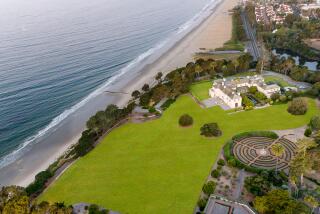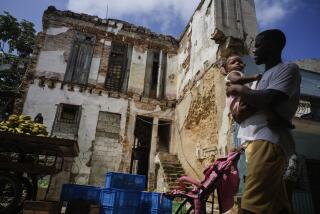Doors Swing Open to Plantations on St. Croix
- Share via
ST. CROIX, U.S. Virgin Islands — If a Caribbean lover needed assurance that Hurricane Hugo is history, the 35th Annual House Tour, sponsored by the St. Croix Landmarks Society next month, is positive proof.
Once again, the doors of private homes--from plantation great houses to choice contemporaries--will be open to benefit the Landmarks Society, an organization that supports island preservation projects.
Tours are offered every Wednesday from Feb. 6 to March 27, and are more than a choreographed peek at how the island elite lives in a tropical paradise; they are more than merely the hands-down U.S. Virgin Islands social event of the year which is unique in the Caribbean.
They are, in fact, a tradition so strong that last March, only six months after Hurricane Hugo battered St. Croix with 200 m.p.h. winds, the Landmarks Society held a tour. It was for only one day instead of six and those who came were island residents, but between the house tour and a gala reception the night before, $110,000 was raised for island preservation projects.
The hit of last year’s tour was on Green Cay island. It was the contemporary home of William Gunther--a home that had been destroyed by Hugo in September and completely rebuilt by March. “It was the miracle we all needed to see,” said co-chairperson Sally Schantz.
Although the 1991 list of houses is not complete and changes are possible until the last minute, each of four weekly tours will concentrate on a particular section of the island and include at least one historic great house, the main house of a plantation.
Firmly set for this winter is Estate Mt. Washington, the showplace home of ardent preservationists Nancy and Tony Ayer. Built on the foundation of a ruined 1750s cotton-sugar plantation just outside Frederiksted, it will be a repeat from two years ago when the final touches were being put on the main house. It includes an old boiling factory, slave quarters and mill ruins.
Since Estate Mt. Washington flourished during the two centuries when Denmark owned the U.S. Virgin Islands, it was logical that the Ayers traveled to Denmark to research their historic property. There they found records that include job descriptions for slaves as well as commercial papers for profitable crops. The house is furnished with both European and rare West Indian antiques including a massive mahogany double-spiral poster bed. The kitchen is an electric version of the 18th Century cook house at Estate Whim Plantation Museum, complete with Danish oven.
In the Kingshill section of the island in central St. Croix, Estate La Reine, home to the first Danish Royal governor-general, has been in the family of present owner William Cissel for 145 years. The 1747 great house has been added onto over the centuries (unlike many, it has been constantly occupied) to make it something of an architectural history of St. Croix.
Unlike most other plantations, the business operation here was in the great house but was kept from encroaching on family life by its separate entrance to the planter’s office. Letters were written on top of the authentic high posting desk and funds kept in an early-1700s Dutch money chest.
La Reine has tray ceilings and an original 1940s planter’s chair made of saman wood plus a child-size version from the 1930s. The chair was designed to elevate the planters’ swollen feet so the houseboys could remove his boots.
While the old great houses were built to oversee the land, the new homes on the tour are oriented to the water.
Take, for example, the modern hilltop home with a 200-degree view of the sea built by Robert Merwin and his artist wife, Jean, on the estate where Merwin was born. Jean Merwin’s paintings may have been inspired by the islands, but the house is an eclectic blend of family antiques, and includes a large collection of 19th and 20th Century quilts.
Should you miss the house tour, you can visit Estate Whim Plantation any time of year. This 18th Century great house with its assorted outbuildings and soon-to-be-functioning windmill, once belonged to Christopher MacEvoy Jr., a wealthy bachelor. Today it is a living museum where fresh-baked johnnycakes are served in the restored cook house. Former storehouses now hold a complete antique apothecary and a gift shop that specializes in island-made crafts.
Whim, the first and ongoing project of the Landmarks Society, was a shell when adopted by the fledgling organization in 1958. It is still the only non-profit house museum in the U.S. Virgin Islands, and its costumed guides are mines of information about the days when sugar was king.
Once there were nearly 400 sugar and cotton plantations on St. Croix. Thanks to the hazards of wind and fire, only 26 great houses remain, nearly all still in private hands.
Yet the people of St. Croix remain history oriented. The Landmarks Society has more than 450 family memberships making it the island’s largest organization. The group helped create the present National Park and Historic districts.
In addition to being open for viewing, some historic areas and structures are open to the public as hotels.
The land on which the Buccaneer Resort now stands was home to the Knights of Malta when that Mediterranean order ruled briefly in the Virgins.
One of the four buildings that make up Pink Fancy Guest House is a 1780 Danish townhouse on the National Register of Historic Places.
Another small hotel open to the public, the main building of Club Comanche, was a doctor’s residence in 1750 and its old stone mill tower is both a point of orientation on the harbor and a honeymoon hideaway.
Near Frederiksted, Sprat Hall is the only U.S. Virgin Islands plantation whose original structures have been renovated to serve as a hotel, as well as the only French plantation house never in ruins and the oldest (1650-90) intact great house in the northern Caribbean.
Main towns Christiansted and Frederiksted are official National Historic Sites, so there are restaurants in courtyard settings, down alleys and up outside staircases. Even tourist information offices are located in historic places: the old scale house in Christiansted and Fort Frederik in Frederiksted.
Tickets to the three-hour house tours are $20 per person per tour and may be purchased at Estate Whim, as well as assorted shops and offices around the island. Advance reservations are recommended, yet on tour mornings, any leftover tickets are held at a departure point and sold at the last minute.
More to Read
Sign up for The Wild
We’ll help you find the best places to hike, bike and run, as well as the perfect silent spots for meditation and yoga.
You may occasionally receive promotional content from the Los Angeles Times.





